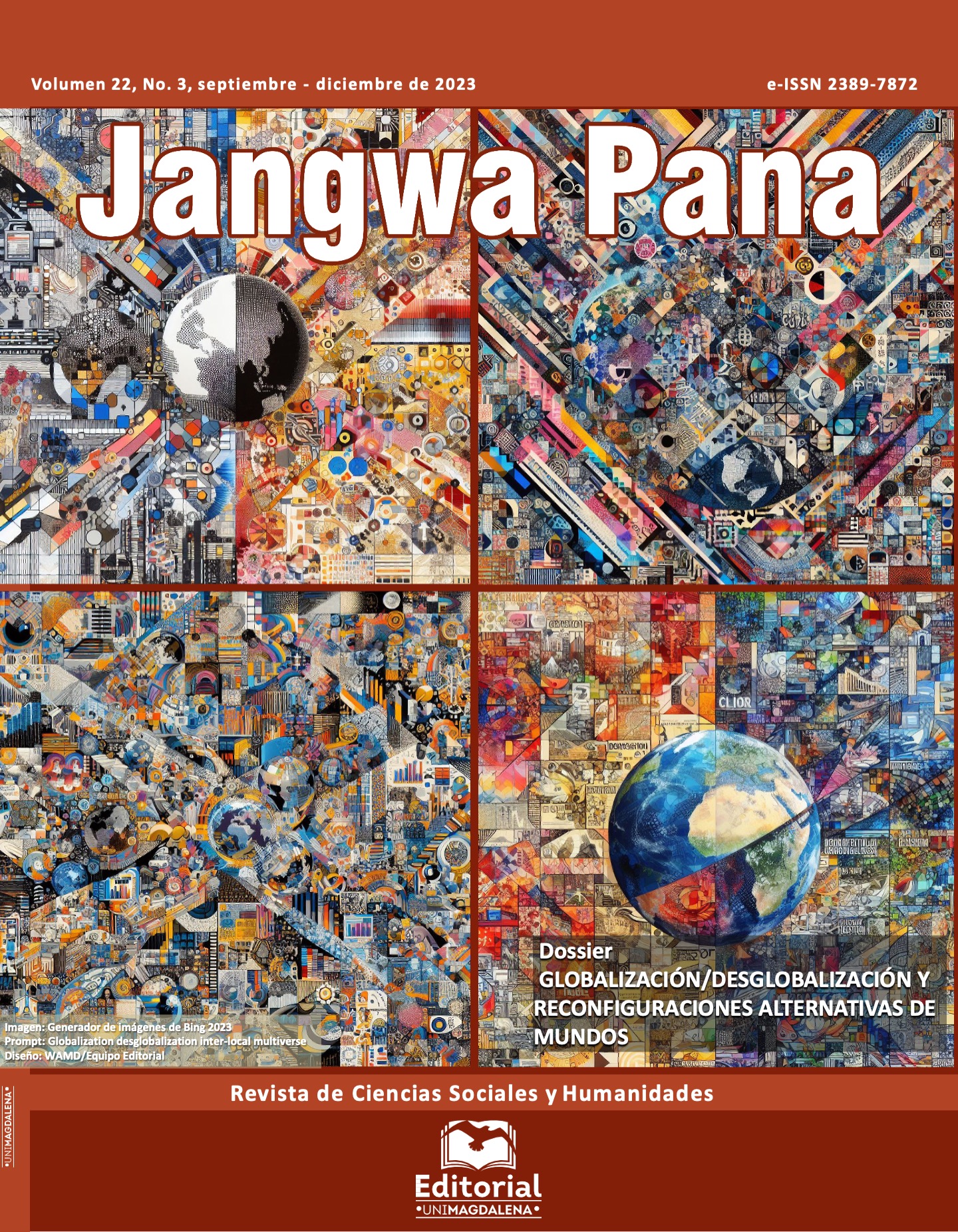The graphic novel Priya's Shakti and the representation of violence against women in India
Main Article Content
Abstract
Downloads
Article Details
References
About. (2014). https://www.priyashakti.com/about/
Aijaz, S. (2015, 21 de enero). Priya's Shakti: Tackling rape through augmented comics. YouStory. https://yourstory.com/2015/01/priyas-shakti-comics
Albarello, F. (2013). Narrativas transmedia: cuando todos los medios cuentan. Austral Comunicación, 2(2).
Arpana, R. (2013). Gandhian Concept of Truth and Non-Violence. Journal Of Humanities And Social Science, 18(4), 67-69.
Aston, J. (2017). I-Docs: The Evolving Practices of Interactive Documentary. Columbia University Press; Wallflower Press.
Babu, B. V., & Kar, S. (2009). Domestic violence against women in eastern India: a population-based study on prevalence and related issues. BMC Public Health, 9(129), 1-15.
Beristáin, H. (1984). Análisis estructural del relato literario. Universidad Nacional Autónoma de México.
Bosworth, M., & Lakshmi, S. ( 2018). Crafting Stories for Virtual Reality. Routledge.
Chattopadhyay, D. (2017). Can comic books influence consumer awareness and attitude towards rape victims and perpetrators in India? The case of Priya’s Shakti. Journal of Graphic Novels and Comics, 10(1), 28-46.
Clarín. (2018, 12 de julio de 2018). Así fue el más brutal caso de violación en la India, que ahora culmina en la horca. https://www.clarin.com/mundo/brutal-caso-violacion-india-ahora-culmina-horca_0_S1jqMxHm7.html
Cooper, J. (2004). Diccionario de símbolos. Gustavo Gili.
Cooperativa.cl. (2014, 18 de diciembre). Mediante un cómic buscan combatir las violaciones en India. Cooperativa.cl. https://cooperativa.cl/noticias/mundo/india/mediante-un-comic-buscan-combatir-las-violaciones-en-india/2014-12-18/113145.html
Devineni, R. (2014). About. https://www.priyashakti.com/about/
Devineni, R. (2019). Priya y las chicas perdidas (capítulo 3). Rattapallax. https://www.priyashakti.com/priya-lost-girls
Devineni, R., & Menon, Vikas. K. (2014). Priya's Shakti (capítulo 1). Rattapallax. https://www.priyashakti.com/priyas-shakti
Eliade, M. (1981). Lo sagrado y lo profano. Guadarrama.
Fombona, J., Pascual, M., & Ferreira, M. F. (2012). Realidad aumentada, una evolución de las aplicaciones de los dispositivos. Pixel-Bit. Revista de Medios y Educación, (41), 197-210.
Freeman, M., & Proctor, W. (2014). Global convergence cultures: Transmedia Earth. Routledge.
Fuerte de Jaisalmer. (2023). Viaje por India: https://www.viajeporindia.com/fuerte-jaisalmer-fortaleza-habitada-rajastan/
García, Canclini N. (2016). Culturas híbridas: estrategias para entrar y salir de la modernidad. De Bolsillo.
Ginzburg, C. (1999). Mitos, emblemas, indicios morfología e historia. Gedisa.
Joshi, P. (2016, 14 de octubre). All about Priya’s Shakti: India’s first feminist superhero comic. Hindustan Times. https://www.hindustantimes.com/art-and-culture/all-you-need-to-know-about-priya-s-shakti-india-s-first-feminist-superhero-comic/story-uqGTqxSssb6XIiMvq6BbpI.html
Kaia. (2023). https://www.priyashakti.com/kaia
Kindersley, D. (2015). El libro de las religiones. Altea.
Kosuta, M. (2012). Rahu, Mars, and Saturn the Villain Stars and the Making of a Villain in Thai Astrology. En L. Seaber (Ed.), Cover Villains and Heroes, or Villains as Heroes? Essays on the Relationship between Villainy and Evil (pp. 19-24). Rodaballo.
Kumar, M., & Walia, A. (2016). Elucidation of the indian salwar kameez. International E-Journal of Advances in Social Sciences, 2(6), 756-761.
Landaburu, A. (2015, 18 de septiembre). Priya, la superheroína india que lucha contra la violencia de género. El Diario Vasco. https://www.diariovasco.com/internacional/asia/201509/18/priya-superheroina-india-lucha-20150918175908.html
López, M. (2012). Gandhi, política y Satyagraha. Ra Ximhai, 8(2), 39-70.
Nieto, O. (2015). Teoría general de lo fantástico. Del clásico al posmoderno. Universidad Autónoma de la Ciudad de México.
Pachón, D. (2013). Praxis y emancipación en el joven Marx. Amauta, (22), 153-175.
Pande, R., & Nadkarni, S. (2016). I Will Tell Your Story: New Media Activism and the Indian «Rape Crisis». Journal of Feminist Scholarship, (11), 28-45.
Pelegero, C. (2017). Priya´s Shakti: Una heroína diferente [Trabajo final de grado, Universidad Pompeu Fabra].
Peralta, I. (2016). Priya Shakti Un cómic que ayuda al cambio cultural con pespectiva de género. Aularia: Revista Digital de Comunicación, 5(2), 77-82.
Preciado Solís, B. (1992). El hinduismo. Revista Mexicana de Ciencias Políticas y Sociales, 75-85.
Rege, S. (1996). Caste and Gender: The Violence Against Women in India (EUI Working Paper 17).
Royston, E. (2001). Diccionario de religiones. Fondo de Cultura Económica.
Sarao, K. (2014). Pilgrimage to Mt Kailash: The Abode of Lord Shiva. Dialogue Quartely, 16(2), 214-231.
Scolari, C. A. (2014). Narrativas transmedia: nuevas formas de comunicar en la era digital. En J. Celaya (Dir.), Anuario AC/E de cultura digital (pp. 71-81). Acción Cultural Española.
Shrivastava, N. (2018). The Representation of Gender and Sexuality in Priya’s Shakti (2012). South Asian Review, 39(1-2), 212-226.
Smears, A. (2019). Mobilizing Shakti: Hindu Goddesses and Campaigns Against Gender-Based Violence. Religions, 10(6), 381.
Tamsin, B. (2010). Religion as a bridge between theory and practice in work on violence against women in Rajasthan. Journal of Gender Studies, 19(4), 361-375.
Treibel, G. (2014, 26 de diciembre). La diosa montada. Página 12. https://www.pagina12.com.ar/diario/suplementos/las12/13-9393-2014-12-26.html
Tripathi, R. (2014). Siva in Sanskrit Literature, Radhavallabh Tripathi. Dialogue Quarterly, 16(2), 19-33. http://www.asthabharati.org/Dia_Oct%20014.pdf
Vattimo, G. (1987). El fin de la modernidad, nihislismo y hermenéutica en la cultura posmoderna. Gedisa.
Vattimo, G. (1990). La sociedad transparente. Ediciones Paidós.
Vemuri, A. (2016). After Nirbhaya: Anti-Sexual Violence, Activism and the Politics of Transnational Social Media Campaigns. McGill University.
Verma, N. M. P., & Srivastava, A. (2021). The Routledge Handbook of Exclusion, Inequality and Stigma in India. Routledge.
Vohra, P., & Devineni, R. (2016). El espejo de Priya (capítulo 2). Rattapallax de https://www.priyashakti.com/priyas-mirror

